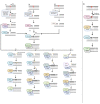Base Excision Repair: Mechanisms and Impact in Biology, Disease, and Medicine
- PMID: 37762489
- PMCID: PMC10531636
- DOI: 10.3390/ijms241814186
Base Excision Repair: Mechanisms and Impact in Biology, Disease, and Medicine
Abstract
Base excision repair (BER) corrects forms of oxidative, deamination, alkylation, and abasic single-base damage that appear to have minimal effects on the helix. Since its discovery in 1974, the field has grown in several facets: mechanisms, biology and physiology, understanding deficiencies and human disease, and using BER genes as potential inhibitory targets to develop therapeutics. Within its segregation of short nucleotide (SN-) and long patch (LP-), there are currently six known global mechanisms, with emerging work in transcription- and replication-associated BER. Knockouts (KOs) of BER genes in mouse models showed that single glycosylase knockout had minimal phenotypic impact, but the effects were clearly seen in double knockouts. However, KOs of downstream enzymes showed critical impact on the health and survival of mice. BER gene deficiency contributes to cancer, inflammation, aging, and neurodegenerative disorders. Medicinal targets are being developed for single or combinatorial therapies, but only PARP and APE1 have yet to reach the clinical stage.
Keywords: 5′-Gap; APE1; NEIL1/2; OGG1; PARP; PNKP; POL β; RECQ1; XPF-ERCC1; XRCC1; base excision repair (BER); nucleotide incision repair (NIR); replication-associated; transcription-associated.
Conflict of interest statement
The authors declare no conflict of interest.
Figures


 ] sign are target BER inhibitors. The figure was generated using Biorender.com (accessed on 20 August 2023).
] sign are target BER inhibitors. The figure was generated using Biorender.com (accessed on 20 August 2023).
Similar articles
-
Beyond Nucleotide Excision Repair: The Importance of XPF in Base Excision Repair and Its Impact on Cancer, Inflammation, and Aging.Int J Mol Sci. 2024 Dec 19;25(24):13616. doi: 10.3390/ijms252413616. Int J Mol Sci. 2024. PMID: 39769376 Free PMC article. Review.
-
A chemical and kinetic perspective on base excision repair of DNA.Acc Chem Res. 2014 Apr 15;47(4):1238-46. doi: 10.1021/ar400275a. Epub 2014 Mar 19. Acc Chem Res. 2014. PMID: 24646203 Free PMC article.
-
A new sub-pathway of long-patch base excision repair involving 5' gap formation.EMBO J. 2017 Jun 1;36(11):1605-1622. doi: 10.15252/embj.201694920. Epub 2017 Apr 3. EMBO J. 2017. PMID: 28373211 Free PMC article.
-
Long patch base excision repair in mammalian mitochondrial genomes.J Biol Chem. 2008 Sep 26;283(39):26349-56. doi: 10.1074/jbc.M803491200. Epub 2008 Jul 17. J Biol Chem. 2008. PMID: 18635552 Free PMC article.
-
Base excision repair.Cold Spring Harb Perspect Biol. 2013 Apr 1;5(4):a012583. doi: 10.1101/cshperspect.a012583. Cold Spring Harb Perspect Biol. 2013. PMID: 23545420 Free PMC article. Review.
Cited by
-
A cross-sectional study comparing the expression of DNA repair molecules in subjects with and without atherosclerotic plaques.Mol Biol Rep. 2024 Sep 4;51(1):953. doi: 10.1007/s11033-024-09886-8. Mol Biol Rep. 2024. PMID: 39230767
-
Epigenetic Dysregulation in Cancer: Implications for Gene Expression and DNA Repair-Associated Pathways.Int J Mol Sci. 2025 Jul 7;26(13):6531. doi: 10.3390/ijms26136531. Int J Mol Sci. 2025. PMID: 40650308 Free PMC article. Review.
-
Identification of novel causally related genes in adenomyosis: An integrated summary data-based Mendelian randomization study and bioinformatics analysis.Medicine (Baltimore). 2025 Jun 13;104(24):e42768. doi: 10.1097/MD.0000000000042768. Medicine (Baltimore). 2025. PMID: 40527793 Free PMC article.
-
Joining of DNA breaks- interplay between DNA ligases and poly (ADP-ribose) polymerases.DNA Repair (Amst). 2025 May;149:103843. doi: 10.1016/j.dnarep.2025.103843. Epub 2025 May 2. DNA Repair (Amst). 2025. PMID: 40347914 Review.
-
Mechanisms of radiation-induced tissue damage and response.MedComm (2020). 2024 Sep 20;5(10):e725. doi: 10.1002/mco2.725. eCollection 2024 Oct. MedComm (2020). 2024. PMID: 39309694 Free PMC article. Review.
References
-
- Gupta R.C., Lutz W.K. Background DNA damage for endogenous and unavoidable exogenous carcinogens: A basis for spontaneous cancer incidence? Mutat. Res. 1999;424:1–8. - PubMed
Publication types
MeSH terms
Grants and funding
LinkOut - more resources
Full Text Sources
Research Materials
Miscellaneous

